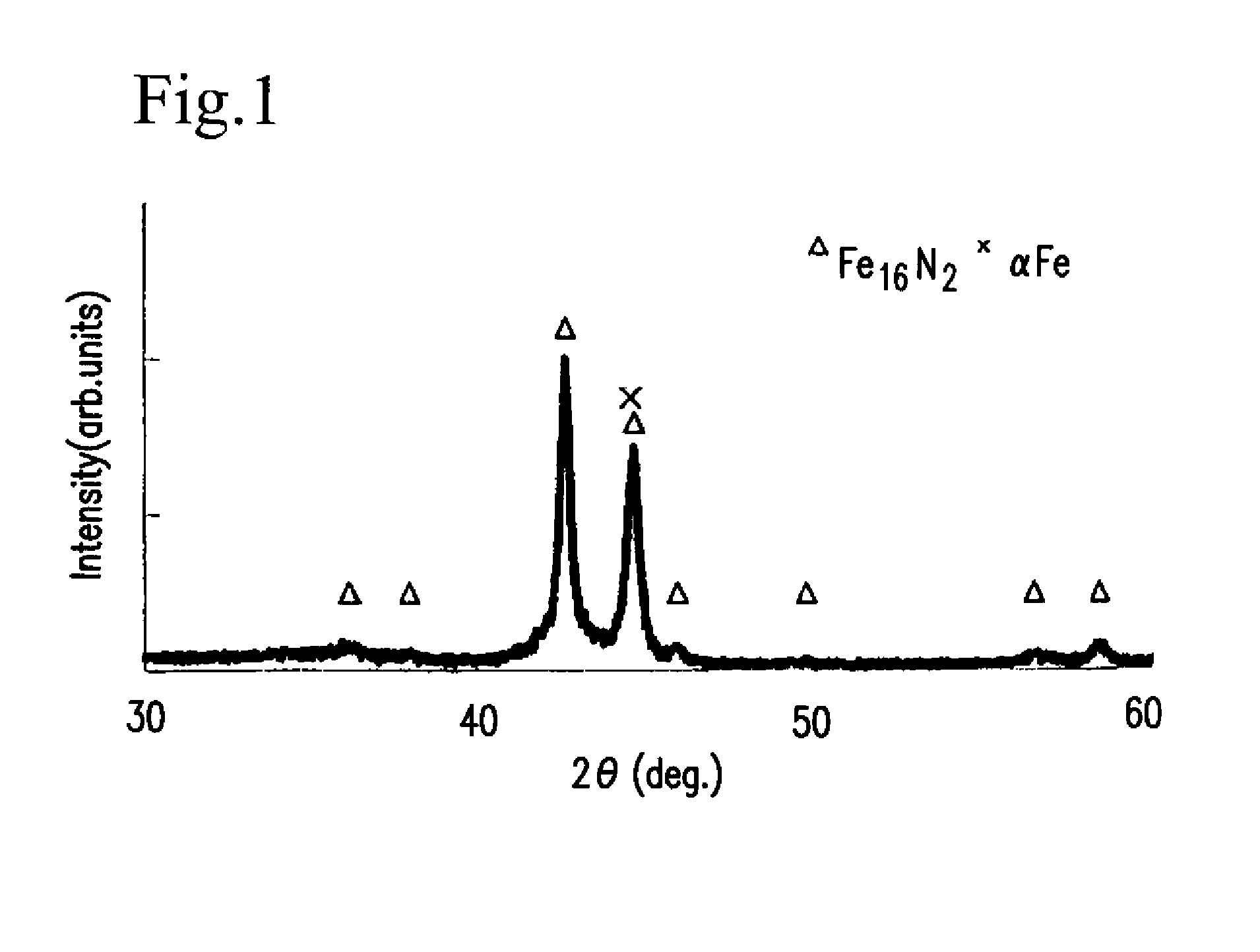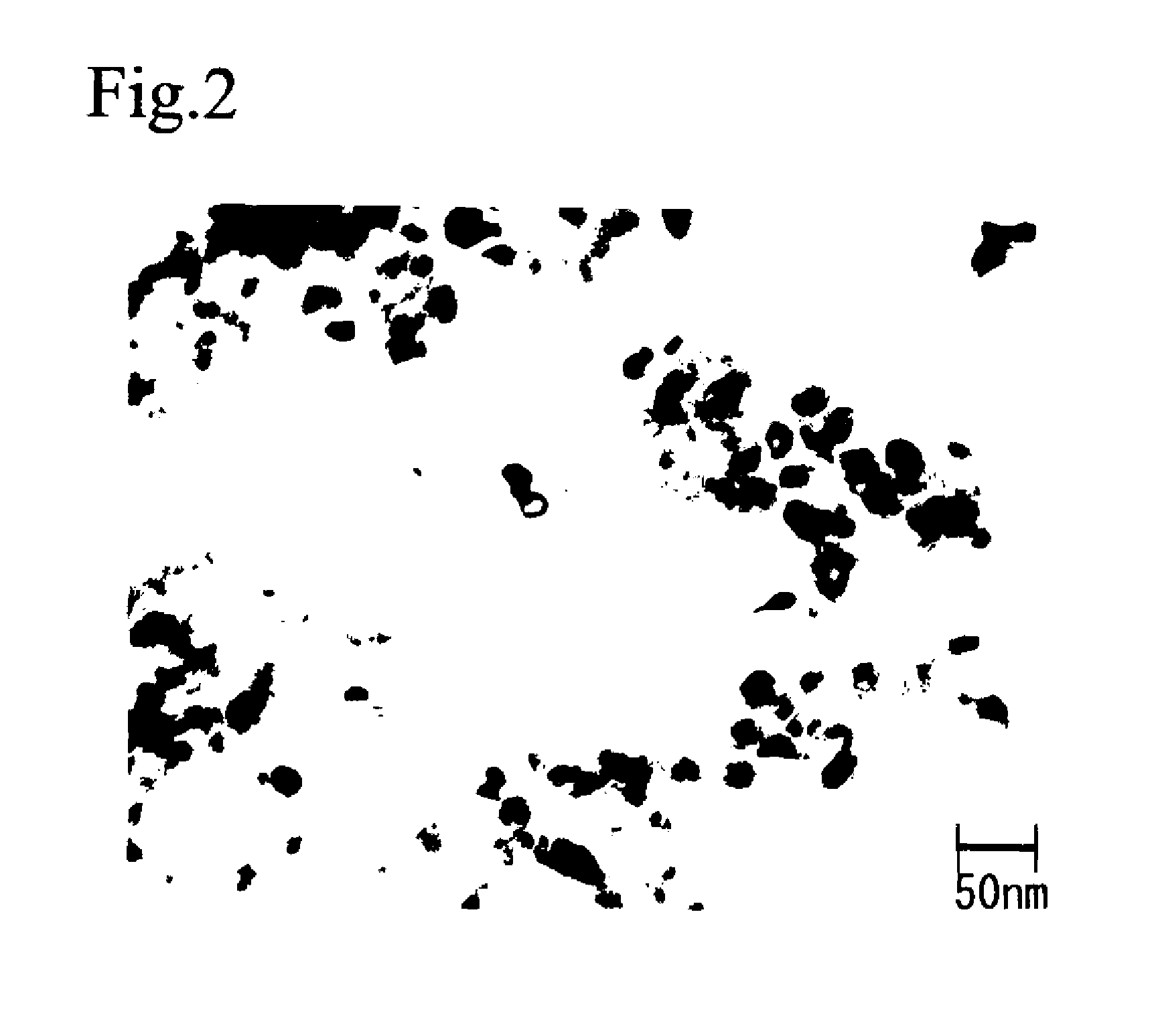Magnetic recording medium
a recording medium and magnetic technology, applied in the field of magnetic recording mediums, can solve the problems of surface smoothness of magnetic layers and worsening of electromagnetic conversion properties, and achieve excellent short wavelength recording properties, small particle size, and high output.
- Summary
- Abstract
- Description
- Claims
- Application Information
AI Technical Summary
Benefits of technology
Problems solved by technology
Method used
Image
Examples
example 1
(A) Preparation of Iron Nitride Magnetic Powder
[0132] Magnetite particles having a substantially spherical shape and an average particle size of 25 nm (10 g) was dispersed in water (500 cc) with an ultrasonic disperser for 30 minutes. To this dispersion, yttriumnitrate (2.5 g) was added and dissolved followed by stirring for 30 minutes.
[0133] Separately, sodium hydroxide (0.8 g) was dissolved in water (100 cc). This aqueous solution of sodium hydroxide was dropwise added to the above dispersion over about 30 minutes. After the addition of the aqueous solution, the mixture was stirred for further 1 hour. Thereby, yttrium hydroxide was deposited on the surfaces of the magnetite particles. Then, the magnetite particles was washed with water and filtrated. The recovered particles were dried at 90° C. to obtain a powder comprising the magnetite particles the surfaces of which were covered with yttrium hydroxide.
[0134] The powder comprising the magnetite particles the surfaces of whic...
example 2
[0149] A magnetic tape was produced in the same manner as in Example 1 except that the thickness of the magnetic layer after the orientation in a magnetic field, drying and calendering was changed to 50 nm in the production process of the magnetic tape, and then the tape was set in a cartridge to obtain a tape for a computer.
example 3
[0150] In the production process of an iron nitride magnetic powder according to Example 1, the magnetic powder, which had been coated with yttrium hydroxide, was redispersed in a solution of 0.07 mole of boric acid dissolved in 30 cc of water, then the dispersion was filtrated and the powder was dried at 60° C. for 4 hours to remove water. Thereby, a magnetic powder, the particles of which were covered with yttrium containing boron, was obtained. This magnetic powder was reduced with hydrogen, nitrided with ammonia and stabilized in the same manner as in Example 1 to obtain a yttrium-iron nitride-boron magnetic powder.
[0151] The contents of yttrium and nitrogen of the resulting yttrium-iron nitride-boron magnetic powder were analyzed with a fluorescent X-ray analysis and 4.0 atomic % and 9.0 atomic %, respectively, based on the amount of iron. The content of boron was 3.0 atomic %. The X-ray diffraction pattern showed the profile corresponding to the Fe16N2 phase.
[0152] Furthermo...
PUM
| Property | Measurement | Unit |
|---|---|---|
| particle size | aaaaa | aaaaa |
| particle size | aaaaa | aaaaa |
| thickness | aaaaa | aaaaa |
Abstract
Description
Claims
Application Information
 Login to View More
Login to View More - R&D
- Intellectual Property
- Life Sciences
- Materials
- Tech Scout
- Unparalleled Data Quality
- Higher Quality Content
- 60% Fewer Hallucinations
Browse by: Latest US Patents, China's latest patents, Technical Efficacy Thesaurus, Application Domain, Technology Topic, Popular Technical Reports.
© 2025 PatSnap. All rights reserved.Legal|Privacy policy|Modern Slavery Act Transparency Statement|Sitemap|About US| Contact US: help@patsnap.com


